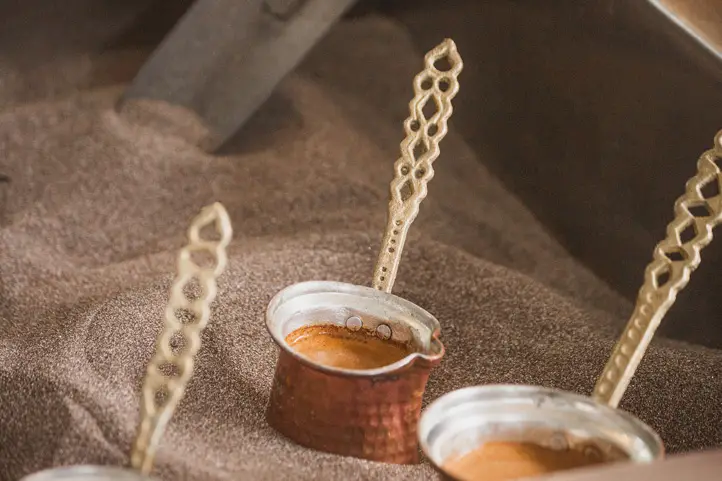Turkish coffee or Turkish-style coffee was declared an Intangible Cultural Heritage of Humanity in 2013 due to its special and traditional characteristics of preparation and serving.
This particular method is widely used in Turkey and neighboring countries. Known locally as kahve or türk kahvesi, it is one of the oldest recorded coffee brewing methods.
If black and strong coffee is one of your preferences, you will surely like to try this Turkish wonder coffee because it is quite strong. Below we will explain in detail what Turkish coffee is, how to prepare it and tell a little about its history.
Table of Contents
What exactly is Turkish coffee?
With this method of preparation, the coffee is made with a small amount of water and a large amount of coffee, boiled for a few seconds and left to steep for a few minutes before serving.
The coffee beans used are finely ground and mixed with water in a cezve (coffee pot), called ibrik in Turkey. It is served unfiltered in Demitas cups.
The ratio of water and coffee when preparing Turkish coffee is 10 g of coffee to 100 ml of water.
Sometimes it is prepared with sugar and spices such as cardamom and cloves. In cafés it is usually served on a tray with a small glass of water and a candy.
It should be drunk in four or five sips, but part of it is not drunk in order not to swallow the dregs of the ground coffee, and it is not usually served with milk or cream.
What is needed to prepare Turkish coffee?
Before venturing into the preparation, it is useful to know what cezves and demitas are and which coffee is used in this Turkish recipe.
Cezve cooking pot for Turkish coffee
Cezve is a Turkish word of Arabic origin meaning a burning piece, embers or piece of fire. The word cezve probably originated in the Ottoman period as part of the history of Turkish coffee, as coffee was originally discovered in Yemen province.
Cezves are shaped like a pitcher and have a very long handle. They are also called jezves or gezves. They come in different sizes and it’s important to use the right size for the number of cups you want to make.
There are three categories.
- Large: These can brew up to 10 cups of Turkish coffee.
- Medium: These are designed for 3 to 4 cups.
- Small: They make 1 or 2 cups.
Cezves are also made from a variety of materials. This is an important point as each material has its own ability to retain heat.
Below their material from best to worst ranks them:
- Silver
- Copper
- Gold
- Aluminum
- Platinum
- Stainless steel
The most common cezves are made of copper, as it is almost as good as silver, but their price is 10 times lower, between $25 and $30.
Demitas cups for Turkish coffee
Turkish coffee is served in demitas or demitas cups on a saucer. These are small cups with a capacity of 60 to 90 ml.
They are available in different versions. Demitas cups with a wide base and a mug-like shape are recommended for drinking Turkish coffee.
The wider base ensures a thinner layer of coffee sediment and also serves as a container for collecting the coffee grounds when drinking from the cup.
What kinds of coffee beans are used for Turkish coffee?
The Turks use coffee beans from all over the world because coffee does not grow in Turkey. It is important that the coffee is made from Arabica coffee beans. This differs from Greek coffee, which is made from Robusta coffee beans.
The roast that is predominant in Turkey is dark, which means that the coffee tastes rather bitter.
Turkish coffee requires a fine grind, which is usually made at home using a hand grinder.
The most popular brand is Kurukahveci Mehmet Efendi. Two pounds of this brand cost around $30.
You can also buy ground espresso coffee for a similar price. While it’s not as fine as Turkish coffee, it can work if you have no other choice.
How to make Turkish coffee step by step
To prepare 2 cups of Turkish coffee we will need the following:
- 1 cezve of any size
- 150ml of water
- 1 tablespoon of ground coffee (15 g). If we want to grind coffee at home, we need 15 g of coffee beans. However, we recommend adding a few more grams, as there may be a few grams left in the grinder and a few grams left over in the process.
- Sugar (optional)
When we have everything prepared, we can carry out the next steps:
1. Grind coffee
First, the coffee beans are ground by hand until they are very fine.
Few electric grinders are capable of grinding coffee fine enough for Turkish coffee.
*If you don’t have a coffee grinder, you can buy the coffee already ground and go straight to step 2.
2. Heat the water in the saucepan
Add the room temperature water and heat until just before boiling point. In other words, until it starts bubbling up the sides of the cezve.
3. Add the ground coffee
When the water starts to boil, remove from the heat and add the ground coffee. The coffee will foam, but shouldn’t spill over unless the cezve is very small.
To get more foam, which is the goal, you can put the cezve back on the stove for 2 or 3 seconds, remove it and repeat the process. We must always be careful not to lose the foam.
Then we let the whole thing stand for 2 or 3 minutes. Never stir during or after brewing.
4. Serve
Once the coffee is prepared, pour almost the entire contents of the unfiltered coffee maker into Demitas cups. We can sweeten with sugar to taste.
The coffee residue sinks to the bottom and forms a layer at the bottom of the cup. This is comparable to the dregs in a cup of coffee made with a French press.
Hot sand method of brewing Turkish coffee
One of the special traditions of Turkish coffee is the use of hot sand. It’s a method that doesn’t alter the flavor but perhaps takes us to a more traditional but less practical experience.
This method has its origins in the hot sands of Turkey and the Arabian Peninsula. Especially in the less populated areas where there is more sand and the climate is much hotter.
Its use is simple and intuitive: instead of a fire or a stove, the hot sand is used to heat the cezve. The temperature should be between 50°C and 100°C.
To use this method, a bowl is filled with sand and heated. This can be done on the stove. Then we stick the cezve in the sand; the deeper we insert it, the hotter it gets.
Then we continue with the normal recipe. Remove the cezve from the sand, add the coffee, and place back in the sand up to 3 times.
Using hot sand slows down the brewing process but is easier to control since the intensity of the heat input is determined by the depth of the bowl. Going slower also gives us more time to “maneuver” the cezve and prevent the coffee from completely boiling over, which would remove all the foam.
History of Turkish Coffee
The entire area of today’s Turkey was under the rule of the Ottoman Empire. These included the Arabian Peninsula, the Middle East, Greece, the Balkans and North Africa.
So, this way of making coffee is very common in the region, and each area has its own variations depending on the type of coffee bean or the utensils used.
Coffee came to these areas from Ethiopia and Yemen in the 16th century when the first coffeehouses opened. In 1517, the Ottoman Empire invaded Yemen and brought coffee to the Sultans of Istanbul. It was very well received, and already roasted Yemeni coffee was imported.
In the 17th century, European travelers learned about coffee in Turkey and brought it to Europe. Later it was even banned, and it took a century for it to cross the Atlantic and reach America.
Benefits of Turkish coffee
Turkish coffee prevents the same health problems as any other black coffee. This includes:
- Heart disease and stroke
- Liver diseases such as non-alcoholic fatty liver disease, hepatic fibrosis and cirrhosis
- Type 2 diabetes
- Brain disorders such as depression, Alzheimer’s and Parkinson’s
Because of the bitterness of Turkish coffee, many people drink it with sugar, which increases the calorie count. A serving of sweetened Turkish coffee contains around 11.5g of sugar, bringing the total calories to 46kcal per cup.
Conclusion
Turkish coffee is a traditional and historical way of making coffee. Its essence also lies in the experience of making and enjoying it.
If we even choose the hot sand method, we can almost speak of a ritual that can connect us to other cultures.



